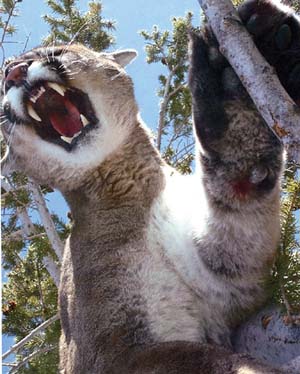Some ranchers and agriculture officials believe a historical
increase to the cougar population
– and a continued ascent since then – correlates with a steady
decline in numbers to the population of deer, mountain lions’
primary food source. The reported deer count in San Benito County,
a local rancher noted, was just more than 50,000 in 1963. Now,
harvest numbers indicate it is between 5,
000 and 6,000.
HOLLISTER
San Benito County ranchers and agriculture officials contend the area’s mountain lion population has been rising for years and poses a growing threat, but the state neglects to keep precise counts on the species and maintains the numbers have remained steady in recent decades.
Agriculture Commissioner Paul Matulich last week, however, said he is “100 percent confident” the frequency of sightings and the species’ tendency to attack livestock has risen. He also contended that any action toward addressing the problem must start at the state level due to its long-running hunting restrictions and a lacking predator management program.
That predator management program has been non-existent for decades, while state voters in 1990 approved Proposition 117 that declared the species as “specially protected” and outlawed mountain lion hunting.
Residents can kill a lion, according to fish and game, under just three circumstances:
– A depredation permit is issued to take a specific lion for killing livestock or pets.
– To preserve public safety
– To protect the threatened big horn sheep
Matulich agreed with a heightening consensus among locals who say they have seen more evidence of lions, sometimes dangerously close to places where people gather, sometimes after the cougars have devoured or injured livestock.
“Years ago, you never would see a lion,” he said. “Now you see them all the time.”
Matulich also works with the county’s wildlife services employee, whose contract is up for renewal at this week’s board of supervisors meeting and carries an $88,000 annual cost.
Although the majority of lion sightings and incidents are reported in rural areas, the local trapper has responded to seven or eight calls to urban areas for such sightings in the past year alone, Matulich said.
In February 2008, city officials on Park Hill got a scare when fish and game confirmed a set of paw prints near office buildings there as that of a mountain lion, though it never appeared to return.
“It’s a problem and it’s going to get worse if they don’t get a handle on it,” he said.
Rancher on a mission
One of those concerned residents is longtime Panoche area cattle rancher Charlie McCullough, who said his own sightings of mountain lions on his property have become far more common than many years ago.
McCullough, who spent 25 years on the county’s fish and game board, noted how the mountain lion population had increased steadily from about 1,000 statewide in 1963 to somewhere between 4,000 and 6,000 in 1988. That’s when the state stopped tracking the species’ numbers.
“They still use that 6,000 figure,” McCullough said.
He also believes that historical increase – and a continued ascent since then – correlates with a steady decline in numbers to the population of deer, mountain lions’ primary food source. The reported deer count in San Benito County, he noted, was just more than 50,000 in 1963. Now, harvest numbers indicate it is between 5,000 and 6,000.
More recently, he contended, an effort by Pinnacles National Monument to remove wild pigs from the park has prompted a lion migration from the public mountainsides onto private ranches to seek out boars, another common food source for cougars in this area. Pinnacles’ Superintendent Eric Brunnemann, meanwhile, could not be reached for comment before press time.
In arguing that state officials should focus on re-establishing a lion count as a start toward reducing the potential danger, McCullough recalled how a mountain lion recently walked by playground equipment on his property but ran off when his dogs started barking.
McCullough is convinced the numbers are rising and even provided some surveillance photos to prove how comfortable the species has become with his own property. One of them, taken a matter of feet from the big cats, shows four cougars drinking from a cement trough near his home.
“The focus should be on the (lion) count,” he insisted.
Following the deer
That would be the first step toward ultimately changing the public perception about the species’ growth and what damage, if allowed to balloon uncontrollably, it could wreak on ranchers’ livelihoods, public safety and overall health of local habits.
Pacines area cattle rancher Curt Graves has broached another idea toward preventing livestock attacks. He believes the county needs an artificial boost to the deer population by transporting them from heavily populated areas such as Pebble Beach and Big Sur.
Though he has not had any cattle killed by mountain lions, Graves recalled how a cougar had attacked a heifer on his property a year ago and clawed both sides of its neck before likely being stomped on and fleeing from the fight.
The gauge he uses to verify that there are more mountain lions around than years ago is observing their tendency to hunt during the day. He noted that the species primarily hunts at night.
“If you see them during the day, they’re hungry,” he said. “They’re not out because they’re taking a stroll.”
He is concerned about future attacks on his livestock and hopes to build the deer population because, he said of the lions near his property, “They don’t have anything to eat.”
For Graves and others concerned about lions, the problem remains at the state level, where fish and game officials follow the perception – based on the number of reported incidents or sightings, which have remained stable – that the overall population has done so as well.
The mountain lion issue might come up today at the 9 a.m. supervisors meeting in light of county trapper Mark Klaussen’s contract renewal.
County Farm Bureau President Gregg Swett, for one, supports maintaining the position and also believes the mountain lion population has increased over the years while no official state counts have been conducted.
“They have to be controlled,” he said. “You don’t want a little girl or little boy to just kind of disappear, and that can happen.”








